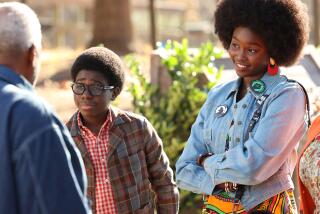Sharing Some of Hollywood’s Secrets
- Share via
The series that pries behind the scenes to show young viewers how Hollywood creates its eye-popping special effects is back for its second season on Discovery Channel--delivering another round of real-life adventures and headaches for the program’s Studio City production company.
“Mega Movie Magic” launched its new season Sunday by revealing how a remote-controlled robot and a computer-generated space battle were created in the NewLine Cinema production “Lost in Space.” Series producer Tracy Verna at GRB Entertainment sent a crew to London and Jim Henson’s Creature Shop to tape the segment.
The half-hour series drew healthy ratings and a CableAce nomination after the network introduced it last year to anchor Discovery Kids, a three-hour block of Sunday morning children’s programming. GRB, which had produced 70 episodes of Discovery’s prime-time “Movie Magic” series over five years, was told to concentrate on the children’s show.
GRB President Gary Benz, who got his start in reality TV by producing stunt segments of ABC’s “That’s Incredible” in 1980, found that the audience for the children’s show was ready-made.
“I knew that kids gravitate to this type of programming,” Benz said, “but I wouldn’t believe 12-year-old boys are so conversant with the production details.”
For the new season, Discovery executives wanted “Mega” to pick up the pace a bit. So GRB responded with a product that won’t send many viewers dozing off: Sunday’s episode contained a head-spinning 889 edits.
Verna squeezes four main stories--about movie, TV or commercial visual effects--into each 22-minute episode, drawing on a combination of actual movie clips, behind-the-scene segments from studio publicity kits, footage shot by GRB crews on movie sets, stock shots, demonstrations by effects artists and how-to-do-this-at-home bits--showing kids making a volcano in their kitchen, for instance.
Coming episodes will unlock secrets of films such as “George of the Jungle,” “Mousehunt,” “Paulie” and “The Borrowers.” But the series won’t reveal the real-life struggles in GRB’s production offices.
Behind-the-scenes shows live only by getting off-the-reel action sequences from studios. Which is why Verna had a bit of the fidgets last week over loose ends that needed to be tied up before “Mega” can air a minute or so of “Flubber” from Walt Disney Productions.
GRB got a call months earlier from Tom Bertino at the famed effects shop Industrial Light & Magic, who said that the story behind “Flubber’s” glowing title goo would make good television. So Verna dispatched a crew to Northern California to shoot Bertino peering through translucent gobs, explaining how he was inspired by a jar of styling mousse.
But last week the film’s star, Robin Williams, who must sign off on the deal, was still wavering over whether to agree to a five-year contract allowing GRB to use his image. “We’re still negotiating the amount of years,” said Verna, studying her office production schedule where “Flubber” is pinned up on Week 7. “That seems to be a little stickler of a point right now.”
Still, she was confident that the wrinkle would be just another tiny bump in the road for a series that proves getting cooperation from studios that normally push to get promotional footage on TV isn’t as easy as it might seem.
Sometimes studio executives just don’t want to part with footage for long-term deals, Benz said. Whereas prime-time newsmagazine and entertainment shows air free clips during first-run promotional windows, GRB buys licensing for future syndication and overseas rights, paying fees averaging $6,000 to $8,000, GRB supervising producer Dan Arden said.
In other cases, studio executives may clear clips but bump a release date, as when “Mega” scheduled a segment on “Mighty Joe Young,” only to have Disney delay the film’s opening until Dec. 11--long after the new season wraps.
*
Then again, Discovery executives may decide they don’t want to be seen as promoting certain movies--NewLine’s 1997 “Spawn,” for one. That had a tremendous buzz in the show’s key 8-to-14-year-old demographic, Verna admitted, but, as Discovery children’s programming vice president Marjorie Kaplan explained, “it’s full of all sorts of pretty horrific imagery. We didn’t want it to look like we were sending kids out to see it.”
By the same token, Discovery executives keep after GRB to get clips from some of their favorites.
“Yes, I wish we’d gotten ‘Titanic,’ ” Kaplan sighed. “I’d take it for this season, I’d take it for any season.”
Licensing problems kept the seagoing disaster epic off of Verna’s schedule, but Sony’s hush-hush monster picture “Godzilla” is right there, pinned up as leading off the Week 13 show.
And then there’s another knotty problem: “Mega’s” basic premise is to explain sometimes complicated special effects, but youngsters in focus groups who watch the rough cuts occasionally admit they just don’t get it--which can send a segment back to the writers.
Some of the focus-group kids have been pressed into service for the new season’s other key element--ordinary-kid sequences that have already become a big hit with the production crew. The season’s show-stopper may well be a segment showing Academy Award-winning makeup artist Matthew W. Mungle (“Bram Stoker’s Dracula”) transforming Reseda seventh-grader K.C. Marten-Paperno into an 85-year-old. Then it’s off to the beach where K.C. goes skateboarding--and draws memorable double takes.
“I’ve never made somebody so young look so old,” Mungle said proudly.
Verna, meanwhile, keeps hearing not only from kids but also from adults who work in the film industry.
“It’s interesting to see how some of the other shops do their techniques,” said effects artist Edward Chiodo. “Everybody in this town watches what everybody else is up to.”
* “Mega Movie Magic” airs Sundays at 10 a.m. on the Discovery Channel. The network has rated it TV-Y7 (may not be suitable for children under the age of 7).
More to Read
The biggest entertainment stories
Get our big stories about Hollywood, film, television, music, arts, culture and more right in your inbox as soon as they publish.
You may occasionally receive promotional content from the Los Angeles Times.










